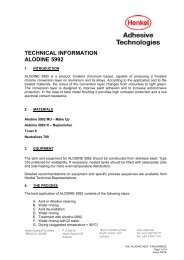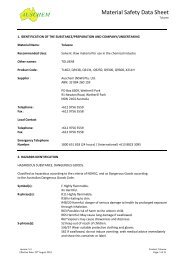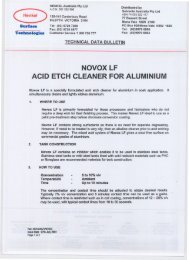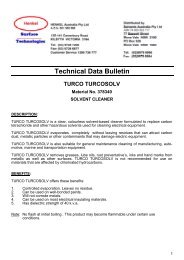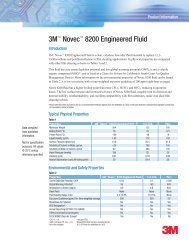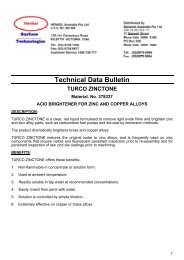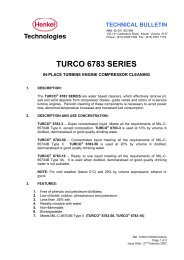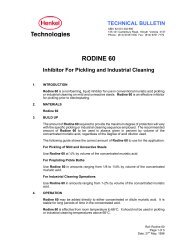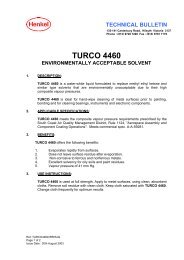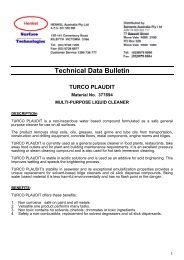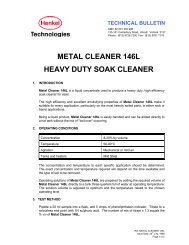Perchloroethylene - Solvents
Perchloroethylene - Solvents
Perchloroethylene - Solvents
You also want an ePaper? Increase the reach of your titles
YUMPU automatically turns print PDFs into web optimized ePapers that Google loves.
Product Name: <strong>Perchloroethylene</strong>MATERIAL SAFETY DATA SHEET Page: 4 of 6This revision issued: July, 2010Odour:Ether-like odour.Boiling Point:121°C at 100kPaFreezing/Melting Point: -23°CVolatiles:Slowly volatile at 100°C, but completely volatile at higher temperatures.Vapour Pressure: 10kPa at 54°CVapour Density:No data.Specific Gravity: 1.619 at 22°CWater Solubility: 0.15g/L at 20°CpH:No data.Volatility:No data.Odour Threshold:No data.Evaporation Rate:No data.Coeff Oil/water distribution: No dataAutoignition temp:No data.Refractive index: 1.5059 at 20°CSECTION 10 - STABILITY AND REACTIVITYReactivity: This product is unlikely to react or decompose under normal storage conditions. However, if you haveany doubts, contact the supplier for advice on shelf life properties.Conditions to Avoid: Avoid direct sunlight or ultraviolet sources. Avoid open flames, welding arcs, or other hightemperature sources which induce thermal decomposition. High energy sources such as welding arcs can causedegradation generating chlorine, hydrogen chloride and possible phosgene, and should be avoided. Avoid contactwith metals such as: aluminium powders, magnesium powders, potassium, sodium, and zinc powder. Avoidunintended contact with amines. Avoid contact with strong bases and strong oxidisers. Avoid prolonged contact withor storage in aluminium or its alloys.Incompatibilities: strong acids, strong bases, strong oxidising agents.Fire Decomposition: Carbon dioxide, and if combustion is incomplete, carbon monoxide and smoke. Hydrogenchloride gas, other compounds of chlorine. Water. Carbon monoxide poisoning produces headache, weakness,nausea, dizziness, confusion, dimness of vision, disturbance of judgment, and unconsciousness followed by comaand death.Polymerisation: This product will not undergo polymerisation reactions.SECTION 11 - TOXICOLOGICAL INFORMATIONThe major route of absorption of <strong>Perchloroethylene</strong> (PCE) is through the Lung: 80% to 90% of inhaled vapour isabsorbed. Skin exposure can appreciably increase absorption. For example, immersion of one thumb in PCE gives anexposure equivalent to breathing about 10 ppm. Additionally, exercising while exposed increases uptake by 50% to300% or more as compared to a resting state.The excretion of PCE is mostly (80-98%) through exhalation of the unchanged compound through the lung. About 2%of an absorbed dose is metabolized to trichloroacetic acid (TCA), which is excreted in the urine. TCA, because of itsbinding to serum albumin, can be detected in the blood or urine for a fairly long time, and has a half-life of about threedays. It is important to note that the metabolism of PCE to trichloroacetic acid is inhibited by ethanol use; thus, a lowTCA level cannot be used to assure safe exposure levels of PCE if the victim also uses alcohol.The half-life of PCE in the blood is not simply determined. Initially, within a few hours of typical occupational exposure,the concentration of PCE measured in blood or expired air drops rapidly, with a half-life of just a few hours. However,one or two days after exposure has ceased, the decline of PCE levels measured in the same way becomes muchslower, with a half-life approaching 3 days.There is more fat storage of PCE than other chlorinated solvents such as trichloroethylene or methyl chloroform. Thismay be responsible for its complex excertion behaviour. Due to this fat storage, repeated exposures generally giverise to higher blood levels of PCE as measured a few days after exposure, than do single exposures.<strong>Perchloroethylene</strong> has been shown to increase the rate of spontaneously occurring malignant tumours in certainlaboratory rats and mice. Other long-term inhalation studies in rats failed to show tumourigenic response.Epidemiology studies are limited and have not established an association between perchloroethylene exposure andcancer. <strong>Perchloroethylene</strong> is not believed to pose a measurable carcinogenic risk to man when handled asrecommended.Birth defects are unlikely. Exposures having no effect on the mother should have no effect on the foetus. Did notcause birth defects in animals, other effects were seen in the foetus only at doses which caused toxic effects to themother.Issued by: <strong>Solvents</strong> Australia Pty Ltd Phone: 02 9979 6866Poisons Information Centre: 13 1126 from anywhere in Australia, (0800 764 766 in New Zealand)
Product Name: <strong>Perchloroethylene</strong>MATERIAL SAFETY DATA SHEET Page: 5 of 6This revision issued: July, 2010Classification of Hazardous IngredientsIngredient<strong>Perchloroethylene</strong>Risk PhrasesConc>=1%: Xn; R40SECTION 12 - ECOLOGICAL INFORMATIONToxic to aquatic organisms, may cause long-term adverse effects to the aquatic environment. Chlorinated solventshave a relatively short life-time in the atmosphere. If spilt into water or soil, trichloroethylene will usually evaporate intothe air, where it is quickly broken down. <strong>Perchloroethylene</strong> and trichloroethylene display very slow biodegradation andresponsible end-users will be very careful to avoid spillages.SECTION 13 - DISPOSAL CONSIDERATIONSDisposal: There are many pieces of legislation covering waste disposal and they differ in each state and territory, soeach user must refer to laws operating in their area. In some areas, certain wastes must be tracked. The Hierarchy ofControls seems to be common - the user should investigate: Reduce, Reuse, and Recycle and only if all else failsshould disposal be considered. Note that properties of a product may change in use, so that the following suggestionsmay not always be appropriate. The following may help you in properly addressing this matter for this product. Thisproduct may be recycled if unused, or if it has not been contaminated so as to make it unsuitable for itsintended use. If it has been contaminated, it may be possible to reclaim the product by filtration, distillationor some other means. If neither of these options is suitable, consider controlled incineration, or landfill.SECTION 14 - TRANSPORT INFORMATIONADG Code: 1897, TETRACHLOROETHYLENEHazchem Code: 2ZSpecial Provisions: None allocatedLimited quantities: ADG 7 specifies a Limited Quantity value of 5 L for this class of product.Dangerous Goods Class: Class 6.1, Toxic Substances.Packaging Group: IIIPackaging Method: P001, IBC03, LP01Class 6 Toxic Substances shall not be loaded in the same vehicle or packed in the same freight container withClasses 1 (Explosives), 3 (Flammable Liquids where the Flammable Liquid is nitromethane), 5.1 (Oxidising Agentswhere the Toxic Substances are Fire Risk Substances), 5.2 (Organic Peroxides where the Toxic Substances are FireRisk Substances), 8 (Corrosive Substances where the Toxic Substances are cyanides and the Corrosives are acids),Foodstuffs and foodstuff empties. They may however be loaded in the same vehicle or packed in the same freightcontainer with Classes, 2.1 (Flammable Gases), 2.2 (Non-Flammable, Non-Toxic Gases), 2.3 (Toxic Gases), 3(Flammable liquids, except where the flammable liquid is nitromethane), 4.1 (Flammable Solids), 4.2 (SpontaneouslyCombustible Substances), 4.3 (Dangerous When Wet Substances), 5.1 (Oxidising Agents except where the ToxicSubstances are Fire Risk Substances), 5.2 (Organic Peroxides except where the Toxic Substances are Fire RiskSubstances), 7 (Radioactive Substances), 8 (Corrosive Substances except where the Toxic Substances are cyanidesand the Corrosives are acids), 9 (Miscellaneous Dangerous Goods)SECTION 15 - REGULATORY INFORMATIONAICS: This product is compliant with NICNAS regulations.The following ingredient: <strong>Perchloroethylene</strong>, is mentioned in the SUSDP.SECTION 16 - OTHER INFORMATIONAcronyms:ADG CodeAICSCAS numberHazchem NumberIARCSWANOSNTPR-PhraseThis MSDS contains only safety-related information. For other data see product literature.Australian Code for the Transport of Dangerous Goods by Road and Rail, 7th EditionAustralian Inventory of Chemical SubstancesChemical Abstracts Service Registry NumberEmergency action code of numbers and letters that provide information to emergencyservices especially firefightersInternational Agency for Research on CancerSafe Work Australia, formerly ASCC and NOHSCNot otherwise specifiedNational Toxicology Program (USA)Risk PhraseIssued by: <strong>Solvents</strong> Australia Pty Ltd Phone: 02 9979 6866Poisons Information Centre: 13 1126 from anywhere in Australia, (0800 764 766 in New Zealand)
SUSDPUN NumberProduct Name: <strong>Perchloroethylene</strong>MATERIAL SAFETY DATA SHEET Page: 6 of 6This revision issued: July, 2010Standard for the Uniform Scheduling of Drugs & PoisonsUnited Nations NumberTHIS MSDS SUMMARISES OUR BEST KNOWLEDGE OF THE HEALTH AND SAFETY HAZARD INFORMATION OF THE PRODUCT ANDHOW TO SAFELY HANDLE AND USE THE PRODUCT IN THE WORKPLACE. EACH USER MUST REVIEW THIS MSDS IN THE CONTEXT OFHOW THE PRODUCT WILL BE HANDLED AND USED IN THE WORKPLACE.IF CLARIFICATION OR FURTHER INFORMATION IS NEEDED TO ENSURE THAT AN APPROPRIATE RISK ASSESSMENT CAN BE MADE,THE USER SHOULD CONTACT THIS COMPANY SO WE CAN ATTEMPT TO OBTAIN ADDITIONAL INFORMATION FROM OUR SUPPLIERSOUR RESPONSIBILITY FOR PRODUCTS SOLD IS SUBJECT TO OUR STANDARD TERMS AND CONDITIONS, A COPY OF WHICH IS SENTTO OUR CUSTOMERS AND IS ALSO AVAILABLE ON REQUEST.Please read all labels carefully before using product.This MSDS is prepared in accord with the SWA document “National Code of Practice for the Preparation ofMaterial Safety Data Sheets” 2nd Edition [NOHSC:2011(2003)]Copyright © Kilford & Kilford Pty Ltd, July, 2010.http://www.kilford.com.au/ Phone (02)9251 4532Issued by: <strong>Solvents</strong> Australia Pty Ltd Phone: 02 9979 6866Poisons Information Centre: 13 1126 from anywhere in Australia, (0800 764 766 in New Zealand)




